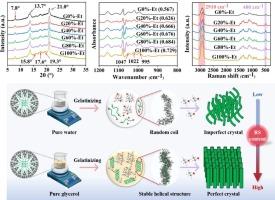甘油对直链淀粉的结构稳定作用促进了v型淀粉的形成,并控制了消化率
IF 12.5
1区 化学
Q1 CHEMISTRY, APPLIED
引用次数: 0
摘要
本研究提出了一种通过诱导直链淀粉构象变化制备低消化率v型淀粉的简单方法。差示扫描量热法发现,随着甘油浓度的增加,淀粉的峰值温度从72.75℃升高到135.31℃,表现出典型的浓度依赖性。这一过程伴随着晶体结构的破坏和淀粉颗粒的膨胀。当糊化介质由水改为甘油时,v型淀粉的近程有序结构得到改善,样品的结晶度提高29.01%。分子动力学模拟结果表明,在甘油体系中,直链淀粉在φ = 83.64°和ψ = 98.18°附近的二面角分布更为集中,表明直链淀粉具有更为稳定和均匀的v型螺旋结构。与水体系相比,甘油体系的平均氢键数和Lennard-Jones势能分别从2.52增加到3.36,从- 322.93降低到- 761.86 kJ/mol,表明甘油分子通过氢键和范德华力与直链淀粉相互作用,稳定了其构象。此外,在纯甘油中制备的完美结晶的v型淀粉的抗性淀粉含量比在纯水中制备的样品高25.06%。本文章由计算机程序翻译,如有差异,请以英文原文为准。

Structure-stabilizing effect of glycerol on amylose promotes the formation of V-type starch with controlled digestibility
This study presents a simple approach to preparing V-type starch with low digestibility by inducing the conformation variation of amylose. Differential scanning calorimetry revealed that when the glycerol concentration was increased, the peak temperature of starch increased from 72.75 to 135.31 °C, indicating a typical concentration dependence. This process was accompanied by the destruction of the crystalline structure and the expansion of starch particles. When the gelatinizing medium was changed from water to glycerol, the short-range ordered structure of V-type starch was improved and the sample's crystallinity was increased by 29.01 %. Molecular dynamics simulations revealed that in the glycerol system, amylose exhibited a more concentrated dihedral angle distribution at approximately φ = 83.64° and ψ = 98.18°, signifying that the amylose had a more stable and uniform V-type helical structure. Compared with the water system, the average H-bonds number and Lennard-Jones potential energy in glycerol system increased from 2.52 to 3.36 and decreased from −322.93 to −761.86 kJ/mol, respectively, indicating that glycerol molecules interacted with amylose and stabilized its conformation through hydrogen bonds and van der Waals forces. Furthermore, the V-type starch with perfect crystals prepared in pure glycerol had a 25.06 % higher resistant starch content than did the sample prepared in pure water.
求助全文
通过发布文献求助,成功后即可免费获取论文全文。
去求助
来源期刊

Carbohydrate Polymers
化学-高分子科学
CiteScore
22.40
自引率
8.00%
发文量
1286
审稿时长
47 days
期刊介绍:
Carbohydrate Polymers stands as a prominent journal in the glycoscience field, dedicated to exploring and harnessing the potential of polysaccharides with applications spanning bioenergy, bioplastics, biomaterials, biorefining, chemistry, drug delivery, food, health, nanotechnology, packaging, paper, pharmaceuticals, medicine, oil recovery, textiles, tissue engineering, wood, and various aspects of glycoscience.
The journal emphasizes the central role of well-characterized carbohydrate polymers, highlighting their significance as the primary focus rather than a peripheral topic. Each paper must prominently feature at least one named carbohydrate polymer, evident in both citation and title, with a commitment to innovative research that advances scientific knowledge.
 求助内容:
求助内容: 应助结果提醒方式:
应助结果提醒方式:


